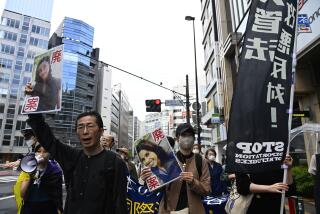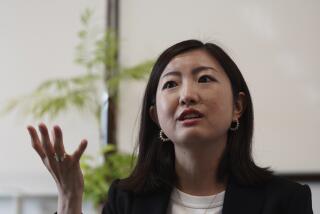COLUMN ONE : Japan Inc. No Friend to Women : Despite legal guarantees of equality, firms openly use female workers as a source of cheap, flexible labor quickly marshaled during good times and let go--as now--during bad.
- Share via
TOKYO — Fresh out of a two-year technical school, Miyuki Hirai, 19, is looking for work as a biotechnologist. But as she pounds the pavement during Japan’s new employee recruitment season, which began last month, she has been told, flat-out, that in this time of economic retrenchment, “We’re taking men but not women.”
No one has been that blunt with a 22-year-old home economics major at Japan Women’s University. But the uncertainty may be worse. Not one of the more than 20 companies with which she has interviewed since March has accepted her, yet no one will tell her why. She has lost 10 pounds, her face has turned haggard with worry and she has begun to wonder, “What in the world is wrong with me?”
For these women and countless others, the problem, it seems, is their gender. Despite Japan’s much ballyhooed 1986 Equal Opportunity Employment Law, aimed at snuffing out sexism in the workplace, women are still the first to go when times get tough for the Japanese.
And as Japan’s economic slowdown forces industry to scramble for cost savings, major firms are matter-of-factly announcing plans to pare the numbers of their women workers far more than those of their men. A recent survey of 2,000 major firms found they intend to reduce their new male hires next year by 5%--but women by 23.7%.
Giant Nomura Securities, for instance, may reduce its work force by 2,000 over the next five years, mostly in jobs held by women. Toyota Motor Co. plans to hire 23% fewer women and 10% fewer men next year. As a result of such hiring plans, the Recruit Co. estimates there will be a net shortage of jobs for women for the first time in eight years.
Besides cutting back regular jobs held by women, many companies are also cutting back their temporary workers, most of whom are female. The Temporary Workers Network, for instance, estimates that contract renewals have fallen this year to 20% from 80% last year.
Labor lawyers proclaim such selective cutbacks of women “illegal.” Yet neither labor unions nor women’s groups seem to be staging any significant protests. On the contrary, the practice constitutes a time-honored way that Japanese industry uses women as a source of cheap, flexible labor that can be quickly marshaled during the good times and eliminated during the bad.
Analysts recall similar cutbacks in the mid-1980s, when major firms such as Nihon Seimei, a life insurance company, cut 3,000 women workers, and during the twin oil shocks.
“Japanese industry has long used women in the role of shock absorber, and in this way the economy was able to develop so well,” said Ikuro Takagi, a professor of social policy at Japan Women’s University.
For their part, companies justify policies of cutting women first by saying the majority tend to quit when they marry or have children. When they return to the market years later, it is usually as temporary or part-time workers.
Industry also argues that the considerable money that firms spend on in-house job training--as much as $160,000 over two years, including salary--is better invested in workers committed to one company their entire lives, namely men. Women’s shorter careers were cited by industry as the No. 1 problem in hiring females in a 1990 Labor Ministry survey.
Although working women in the United States also complain of job discrimination and say that they suffer disproportionately during economic downturns, targeting by gender is relatively easy to do in Japan because of the highly segregated structure of the Japanese labor market.
Regular white-collar workers tend to be divided into two tracks: career and clerical. According to a 1990 study by the Labor Ministry, 97.5% of career-track workers were men; 99% of clerical-track workers were women.
Although both types of workers often end up doing many of the same office tasks--Japan’s system is relatively short on job descriptions--those on the clerical track are spared grueling overtime and transfers in exchange for lower pay and forgoing promotions.
Activists say the cutbacks of women also suggest that the perceived progress under the Equal Opportunity Employment Law may have been illusory.
The nation’s sexist division of labor has largely been maintained under the guise of the two-track system, which a majority of large firms adopted after passage of the law. Before the law, firms blatantly got rid of women or refused to hire them. Now, “firms say they are cutting their clerical jobs, not women, so it’s not discrimination,” said Eiko Shinotsuka, a labor expert at Ochanomizu University. “But the system is still being used to divide women and men.”
Also, the surge of women into the labor force after the law’s passage coincided with Japan’s boom years, a time of runaway land values and a soaring stock market when women were actively recruited for banks and securities firms in particular.
But now that the bubble has burst and diminished the need for women, old-boy attitudes are resurfacing with a vengeance in this largely male chauvinist society where feminism has yet to take deep root. Companies that can now afford to be selective are adding what some women find to be ridiculous job conditions.
“We only take beauties,” one bank recruiter told a job applicant recently, according to the Asahi newspaper. Takagi, the professor of social policy, said that more and more firms also insist that women--and only women--live with their parents.
Firms are nudging women to apply for lower-paying clerical jobs even when they want to apply for sales and other career positions. When Emiko Nakayama, 20, told a recruiter for a trading firm that she wanted to apply for a career-track job, “he didn’t give me a very encouraging look and instead tried to steer me into applying for the clerical position,” she said.
A major motive for pushing women toward the clerical track is economic, since starting pay there can be as much as 40% lower than that on the career track. Several banks, for instance, reportedly plan to hire female clerical workers at lower wages but use them for tasks normally performed by career employees, according to news reports here.
Other motives were bluntly spelled out by Toshihiko Togawa, personnel manager of the Tokyo-based trading firm, Nikishima Shoji.
“Japan is an old-fashioned society. Our customers don’t like women salespeople so we can’t increase the number,” he said with an apologetic shrug, during an interview at a recent job fair. “It’s ridiculous to say, but they think men are more reliable and capable. And of course, women can’t entertain clients with mah-jongg, drinking and golf.
“There’s also the risk that women might fall in love with their male customers and have an extramarital affair, and that would cause problems between the two companies,” Togawa added.
Hardest hit during the current crunch is the group of women who should be expected to fare the best: graduates of Japan’s elite four-year universities.
The reason is economics. University graduates cost more to hire. Many firms seem to assume that most women will have only five good years on the job, quitting when they marry at the nation’s average age of 27. But in recent years, most women have continued to work later--until they have their first child.
Besides, many firms fear that university graduates might not be as willing to make copies, serve tea and perform other mundane work relegated to women, said Seiji Yano, a manager of a Tokyo job placement firm.
To Shinotsuka, the labor expert, industry’s behavior during this economic slowdown is unmasking the unpleasant reality that attitudes toward women have scarcely changed.
“Within the Japanese economy, men have typically performed the main work. Women have been relegated to sub-work, and that has not really changed despite the (equal opportunity) law,” she said. “Women are still regarded as the office flowers.”
A job search guide published by the Nihon Keizai Shimbun advised female applicants, “Appearance, voice and fashion are more important than job ability,” particularly for clerical-track applicants. It quoted a securities firm personnel manager as saying that a bright personality was preferred, but a beautiful woman who looked too sexy risked being rejected because of the company’s worries that she might cause unspecified “trouble.”
But women applying for the career track should know their own mind and not be beautiful because “people will doubt your capabilities,” the newspaper-published manual advised. In short, women intending to apply for both tracks had to master the art of the split personality.
Such stereotyping extends to job-placement ads as well. Even though they’re not supposed to, some ads continue to advertise for men only, such as a recent one in the Nihon Keizai Shimbun for a management research firm.
At Keio University, women-only ads called for “Toyota Pretty” applicants to explain the firm’s auto products in the showroom and at exhibitions; similar ads for Nissan’s “Miss Fair Lady” specified single women between ages 20 and 23, well-balanced physically and mentally, who commuted from their parents’ home. Beauty shop expenses are partially covered, the ad took pains to note.
If much of this sounds legally suspect, labor lawyer Mami Nakano asserts that it is. Firms can’t selectively hire by gender, pressure women to quit or place male-only ads, she says. (Female-only ads are for some reason permitted.)
But because the Equal Opportunity Employment Law carries no penalties and only urges firms to “endeavor” to recruit and hire women, Nakano fears a court challenge based on it alone might fail. Instead, other analysts cite language in the Japanese constitution protecting individual rights and see that as offering other legal methods to protect women from discrimination on the job.
Another vexing problem is the conspicuous lack of public outcry over industry’s behavior, she and others said. That major companies think nothing of announcing cutbacks in terms of women versus men is evidence that “there is absolutely no awareness that this is an illegal act,” asserted Keio University business professor Yoshio Higuchi.
(A Nomura spokesman stressed that the firm was not discriminating against women, saying the firm was also planning to reduce its male hires next year. However, the company’s own figures show that women already have taken a bigger hit than men.)
Still, some women, such as biotechnologist Hirai, say they are simply resigned to such attitudes. Others accept their role as shock absorber as good for the national interest.
A good many others are willing to accept a lesser role as a trade-off for the legal protections women receive against excessive overtime and night work. Women may not work more than six hours of overtime a week and, with some exceptions, may not work between 10 p.m. and 5 a.m.
Such protective laws might seem paternalistic to Americans. But in a nation where “equal opportunity” with men means excessive overtime, a severely limited family life, frequent job transfers and constant demands to drink with colleagues, many women believe their “lesser role” is actually a better one.
Indeed, to meet the demands imposed on those in career-track jobs, most women would have to give up aspirations for children, analysts say. It doesn’t help that husbands spend only an average of eight minutes a day on housework, compared with nearly three hours for working wives. “It’s inhumane. Women either have to choose life only with a career or a balanced family life with a clerical job,” Nakano said.
And women don’t necessarily make it easy for their female colleagues either.
Conflict between career- and clerical-track women was cited in the Labor Ministry survey as one of the top four problems in promoting women, along with the protection law, resistance by customers and their family responsibilities.
A significant number of women are finding the struggle isn’t worth it. In 1987, the Labor Ministry surveyed 55,615 women, focusing on the 2,062 who chose the career track; 10% of the women on the career track quit.
As a result, there is no great rush to eliminate the two-track system or the female protection laws, even though both are used to justify unequal treatment. (It must be said, however, that even the staunchest feminists here call for reforms in grueling Japanese employment practices, which many condemn as cruel for men, as well as women.)
Not until the Equal Opportunity Employment Law is given real teeth should the protectionist laws be abolished, Shinotsuka said. Otherwise, women will be stuck with the worst of both worlds: last hired and first fired at lower pay--yet forced to work grueling overtime.
Takagi of Japan Women’s University said the solution for greater equality between the sexes is to transfer the cost of training workers from individual firms to society, citing the U.S. continuing education system as an example. If that were done, industry could no longer use the excuse that women are a riskier investment in order to cut them first.
But Nakano, the labor attorney, said the future of Japanese working women ultimately rests in working women’s hands. “Unless women themselves become more independent and conscious of the need to defend their own human rights,” she said, “companies and society will not change.”
Chiaki Kitada, a researcher in The Times’ Tokyo Bureau, contributed to this report.
More to Read
Inside the business of entertainment
The Wide Shot brings you news, analysis and insights on everything from streaming wars to production — and what it all means for the future.
You may occasionally receive promotional content from the Los Angeles Times.











